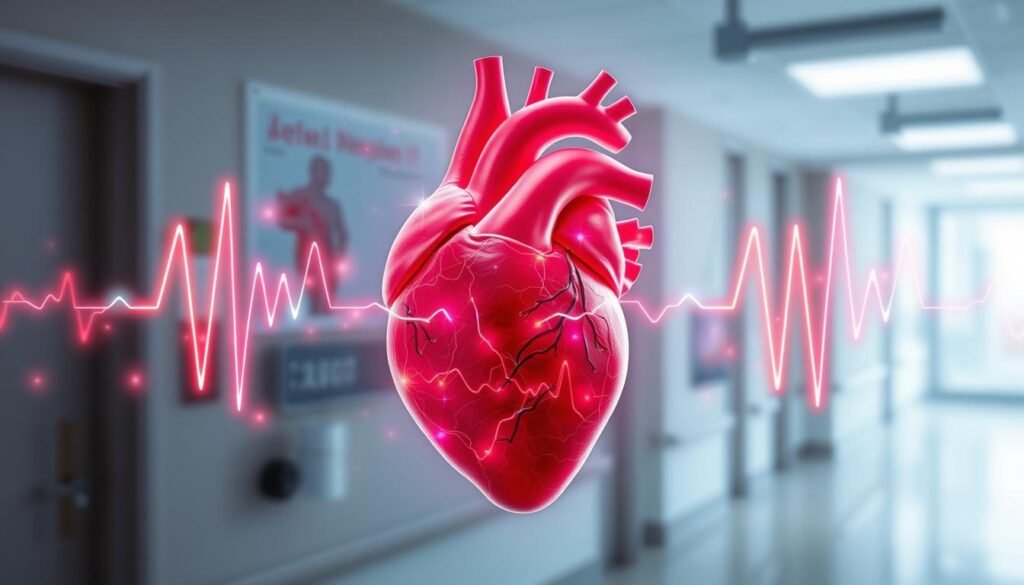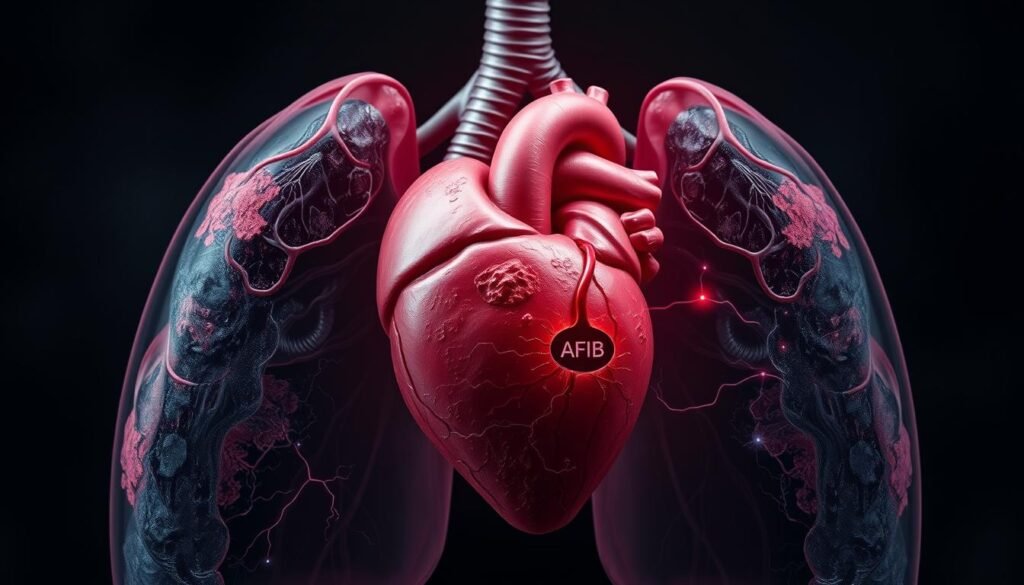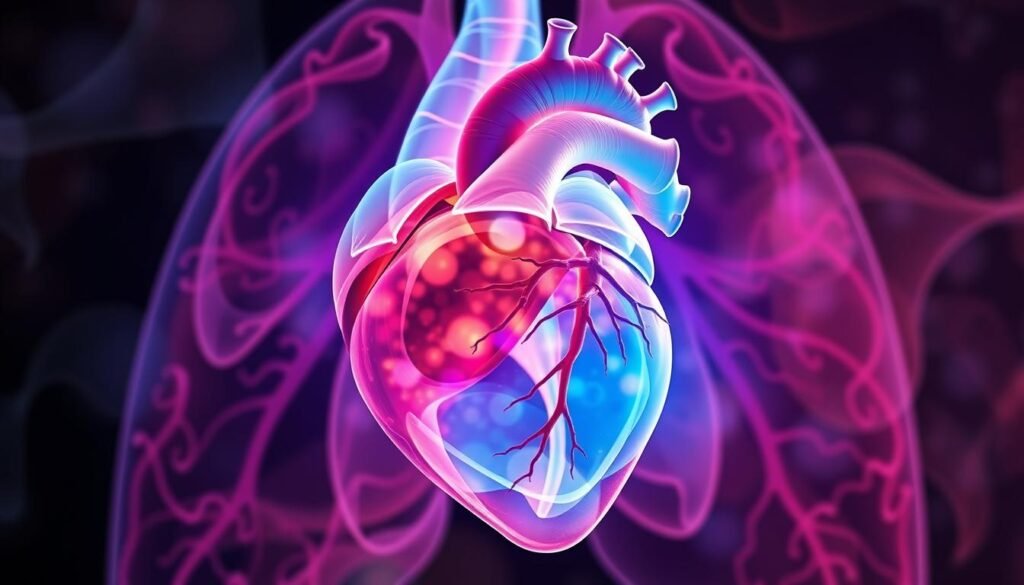For someone with stage 4 non-small cell lung cancer, the five-year survival rate is just 8 percent. This fact highlights the advanced lung cancer’s seriousness, showing us the urgency to understand problems like AFib. In late-stage cancer, the body not only fights the disease but might also deal with heart issues like AFib, making recovery harder.
Experts are learning more about how stage 4 lung cancer and AFib are connected. Managing these issues together can really help improve life for patients. This article will look into how these health challenges interact.
Key Takeaways
- Stage 4 lung cancer has notably low survival rates, necessitating focused treatment approaches.
- Atrial fibrillation can worsen the condition of cancer patients, complicating their treatment.
- Understanding the link between advanced lung cancer and AFib is crucial for effective management.
- Integrated care can enhance the quality of life for patients dealing with both diseases.
- Monitoring heart health is essential in the treatment plan for those with stage 4 lung cancer.
Understanding Stage 4 Lung Cancer
Stage 4 lung cancer is the most serious form of lung cancer, also known as metastatic lung cancer. This means the cancer has moved to other parts of the body. It changes how patients are treated and their health outlook.
Handling this stage is complex. It’s essential to grasp what this stage means, its features, and why knowing the cancer stage is vital.
Definition and Characteristics
At this stage, the tumor has expanded a lot. It may have spread to organs like the liver, brain, or bones. Symptoms like extreme pain, constant coughing, and breathing troubles can greatly affect life quality.
Treatments often focus on easing these symptoms. They also try to keep the cancer from growing further.
Cancer Staging: The Importance of Stage 4 Classification
Cancer staging is key for deciding on treatment. Stage 4 means the disease is advanced. It’s defined using letters and numbers.
- T refers to tumor size.
- N indicates node involvement.
- M represents metastasis.
This system, called the TNM system, shows how much the cancer has grown and spread. Stage 4’s complexity makes treatment tough. This is due to the potential for many organs to be involved. Understanding the stage helps doctors create personalized treatment plans.
| Stage | Definition | Characteristics |
|---|---|---|
| Stage 0 | Non-invasive cancer | Localized, no spread |
| Stage I | Small tumor, localized | Confined to the lung |
| Stage II | Larger tumor, possible lymph node involvement | Spread within the chest area |
| Stage III | Advanced local spread | Involvement of nearby lymph nodes |
| Stage IV | Metastatic lung cancer | Spread to distant organs |
Common Symptoms of Advanced Lung Cancer
Advanced lung cancer leads to symptoms that greatly affect life quality. Recognizing these symptoms early is vital. It helps in starting treatments quickly. This can ease distress and improve care options.
Physical Symptoms to Watch For
Advanced lung cancer patients often face physical issues, like:
- Chronic cough
- Shortness of breath
- Significant pain
- Fatigue and extreme weakness
- Confusion and trouble focusing
- Little interest in eating or drinking
- Restlessness
These symptoms can worsen their well-being. Studies show non-small cell lung cancer can shorten life expectancy to 7 months without treatment. Knowing these signs is crucial.
Impact on Quality of Life
Advanced lung cancer’s symptoms greatly reduce life quality. Pain, trouble breathing, and fatigue can cause distress. Sadly, 85% of lung cancer cases are non-small-cell, impacting many.
Palliative care is essential, aiming to manage symptoms. It improves comfort and provides emotional support. This care helps patients practice self-care and accept caregiver help, boosting their life quality. For more, check this study.
What is Atrial Fibrillation (AFib)?
Atrial fibrillation, called AFib, is an abnormal and quick heart rhythm leading to several issues. Knowing about AFib, including its types and risks, is crucial, mostly for those with certain health problems like cancer.
Overview of AFib and Its Types
There are three kinds of AFib: persistent, permanent, and paroxysmal. Persistent AFib needs help to return to normal and requires treatment. Permanent AFib is consistent and can’t be reverted to a regular rhythm. Paroxysmal AFib episodes are sudden but stop on their own.
Risk Factors for AFib
Studies show cancer patients have greater chances of getting AFib. Conditions such as high blood pressure, diabetes, and being overweight increase AFib risks. Specifically, cancer patients see a rise in AFib cases shortly after being diagnosed. Recognizing these factors is key for proper treatment and care.

The Link Between Stage 4 Lung Cancer and AFib
It’s crucial to understand how stage 4 lung cancer and AFib are connected. Research shows that AFib is quite common in those with lung cancer. About 6.29% of these patients also battle AFib. This fact points out the close link between these two health challenges.
Prevalence of AFib in Lung Cancer Patients
Oncology patients often face a higher risk of AFib. This increase is due to inflammation from the cancer and its treatments. Surgeries, chemotherapy, and radiotherapy all can make AFib more likely because of inflammation.
Studies have found a significant risk increase in AF in the year after being diagnosed with cancer. Lung cancer patients, in particular, are more likely to get AF than those with other types of cancer. That’s why keeping an eye on heart rhythms in these patients is key. AFib can greatly affect a patient’s health.
One study showed a 7.5% AF occurrence in lung cancer patients. This is higher than the 4.3% seen in the broader population. These findings stress the importance of watching for AFib in stage 4 lung cancer patients.
| Study Findings | Percentage |
|---|---|
| Prevalence of AFib in lung cancer patients | 6.29% |
| General population prevalence of AFib | 4.3% |
| Occurrence of AF in cancer patients | 7.5% |

Impact of Metastatic Lung Cancer on Cardiac Health
Metastatic lung cancer affects not just overall health but also heart health. As the disease gets worse, inflammation linked to the cancer may harm heart function. This increases the risk of heart problems.
The Role of Inflammation in Cancer and Heart Disease
Inflammation is key in connecting metastatic lung cancer and heart health. Studies show high inflammation markers, like CRP, can change heart tissue. This change can lead to heart rhythms issues, adding more health risks.
Potential Cardiac Complications During Treatment
Cancer treatments like chemotherapy and radiation can harm the heart. Drugs like cisplatin and paclitaxel may cause heart problems, including uneven heartbeats or heart attacks. Radiation can also lead to serious heart issues, especially if there’s already heart disease.
It’s important to watch heart health closely during cancer treatment. The risk of heart rhythm problems can go up due to the cancer and how it’s treated.

| Cardiac Complication | Associated Treatment | Notes |
|---|---|---|
| Arrhythmia | Chemotherapy (Cisplatin, Docetaxel) | Increased risk during and post-treatment |
| Myocardial Infarction | Chemotherapy (Paclitaxel) | Potentially life-threatening; requires close observation |
| Heart Failure | Radiation Therapy | Higher incidence in patients with existing conditions |
| QTc Prolongation | Osimertinib | 10% of patients may experience this side effect |
Knowing the possible heart risks during cancer treatment is key. This makes it possible to prioritize heart health in cancer care. By understanding inflammation’s effects, we can better manage heart health in patients with lung cancer.
Managing AFib in Cancer Patients
To manage atrial fibrillation (AFib) effectively in cancer patients, a team effort is essential. This team includes oncologists, cardiologists, and primary care doctors. Their interdisciplinary care focuses on the patient’s overall well-being. It considers the complexities of cancer therapies. These treatments can increase bleeding risks, hence, anticoagulant use needs careful consideration.
Importance of Interdisciplinary Care
Interdisciplinary teams are crucial for customizing treatments for cancer patients with AFib. These teams work together to monitor the patient’s reactions and tackle complications. Their collaborative efforts enhance patient outcomes. Providers share insights and create care plans that address both cancer and arrhythmia. Through regular check-ups, they promptly address any suiting needs.
Arrhythmia Management Strategies
Several strategies are in place for managing arrhythmia in cancer patients. These methods aim to optimize heart function and reduce risks.
- Rate control: Beta-blockers and calcium channel blockers are used to keep the heart rate steady.
- Rhythm control: Drugs like amiodarone help regulate heart rhythm, balancing between benefits and cancer therapy interactions.
- Monitoring: Continuous monitoring and adjusting strategies are necessary due to the changing nature of cancer and AFib.
Research indicates that AFib is more common among cancer patients than the general populace, underlining the importance of arrhythmia management. Tools such as the CHADS2 VASc and HAS-BLED scores help in evaluating stroke and bleeding risks. A comprehensive approach improves patient safety and supports the entire treatment process.
| Management Strategy | Description |
|---|---|
| Rate Control | Uses beta-blockers and calcium channel blockers to normalize heart rate. |
| Rhythm Control | Applies antiarrhythmic drugs, mindful of their interactions and risks. |
| Continuous Monitoring | Consistent evaluations to refine treatments based on evolving needs and findings. |
| Risk Assessment | Employs CHADS2 VASc and HAS-BLED scores for stroke and bleeding risk analysis. |
Effects of Chemotherapy on Cardiac Health
Chemotherapy is key in cancer treatment but can harm heart health. It’s a big worry for stage 4 lung cancer patients. Keeping an eye on heart health is crucial. Chemotherapy side effects can raise the risk of arrhythmias like atrial fibrillation (AFib). This can seriously affect cardiovascular health over time.
Chemotherapy Side Effects Linked to AFib
Many studies have found a link between chemotherapy and heart problems. Drugs like anthracyclines (doxorubicin and daunorubicin) can cause cardiomyopathy. This is due to calcium buildup and free radicals in the body. Symptoms include breathing issues and tiredness. Up to 15% of cancer survivors may face heart failure, highlighting the need for careful heart monitoring.
Monitoring Heart Health During Treatment
Keeping tabs on heart health during chemo is vital. Regular checks, like ECGs and echocardiograms, spot heart issues early. Research underlines the value of a joint approach in treating cancer, focusing on chemotherapy’s heart effects. Some centers now use tech similar to pacemakers to help fix heart damage in survivors. For more information, visit the research here.
Treatment Options for Stage 4 Lung Cancer and AFib
Dealing with stage 4 lung cancer and AFib needs a full treatment plan. This includes chemotherapy, targeted therapy, and radiotherapy. These methods aim to keep the cancer from growing and make symptoms better. Yet, with AFib also in the picture, treating both cancer and heart issues together is key.
Advanced Lung Cancer Treatment Strategies
Today’s cancer treatments, like chemotherapy, can sometimes cause heart problems. This is especially true for patients already at risk. Thus, cancer doctors and heart doctors must work together. They aim to fight the cancer while keeping the heart safe. This means picking treatments that don’t interfere with each other or harm the heart.
Heart Rate and Rhythm Control Approaches
For those getting cancer treatment, heart rate control is crucial. Beta-blockers and anticoagulants help a lot. They ease AFib symptoms and cut stroke risks. Strokes are much more likely in AFib patients. Regular check-ups help keep the heart healthy during cancer treatment. For more on the connection between heart and lung health, see this study. Balancing cancer and heart care is vital for patients’ well-being.